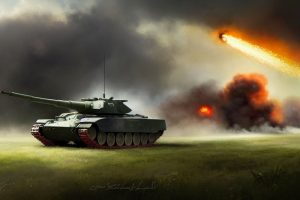China Develops AI-Powered Artillery to Target Taiwan

According to reports, China has been working on artificial intelligence (AI) to increase the accuracy of its artillery attacks. They may utilize it in a future battle with Taiwan. Under the direction of Professor Wang Jiang from the Beijing Institute of Technology, a science team tested AI-powered artillery rounds in July of last year. On April 6, Acta Armamentarii, a peer-reviewed journal, released their research.
Jiang stressed the fast-paced development of AI and its expanding use in trajectory planning issues. It significantly outperformed other artillery systems used by the People’s Liberation Army. The team’s AI-powered laser-guided artillery could kill human-sized targets from 16 kilometers. Pictures from the testing showed the rounds striking the target.
Also Read: The AI Arms Race: A Deadly Rivalry Between the USA and China
Traditional Artillery vs. AI-Powered Smart Shells

In contrast to AI-powered artillery, which can change its trajectory while in flight, traditional artillery shells often land 100 meters or more from their objectives. The enormous amount of real-time data that needs to be computed using conventional mathematical models have reduced their accuracy. AI, on the other hand, provides quicker data processing rates and has the potential to improve precision.
Smart shells with AI capabilities must swiftly collect and examine environmental data to change their route after launch. With more variables, there may be exponentially more computations required. However, to resist the heat and shock of artillery bombardment, the computer chip within the shell must be as essential as feasible. This requirement often leads to discarding critical raw data to complete calculations in time, affecting accuracy.
AI’s Advantages in Data Processing and Trajectory Adjustments

These restrictions can be solved by AI technology. Since even a slow computer chip can do the essential computations utilizing almost all available data. Researchers assert that by learning from data gathered during actual flights or laboratory trials, AI can circumvent some of the more complex calculations made by conventional mathematical models. Jiang’s team divided the work to test multiple models on various tasks. This included complex trajectory modifications while in flight, increasing accuracy.
In urban combat, AI-powered artillery might attack enemy soldiers or vehicles hiding in buildings more effectively than traditional weaponry. Moreover, a defense industry engineer from Beijing said it would do this at a lesser cost than missiles. He added that this technology could help reduce civilian casualties and damage to surrounding buildings. Hence, making reunification and reconstruction after the war easier.
AI-Powered Artillery Rounds: Beyond Expectations
According to the South China Morning Post, photographs taken during tests of AI-powered laser-guided artillery shells showed center strikes on bullseye targets, exceeding expectations for precision. The article emphasized the accuracy limits of the currently guided artillery rounds due to the enormous quantity of real-time data that must be processed using conventional mathematical methods.
AI can handle data faster than conventional mathematical models and avoid complex trajectory calculations by leveraging data from testing or actual firing scenarios. The research team divided the work among its models for various tasks, including complex trajectory modifications while in flight, increasing accuracy. Due to AI-powered artillery, even sluggish microchips in guided artillery rounds can complete all essential computations utilizing all available data.
Our Say

China’s development of AI-guided artillery highlights its increasing importance of it in modern warfare. With the use of AI, weapons can be more accurate and precise, which could reduce collateral damage in conflicts. However, this also raises concerns about potentially escalating regional conflicts, particularly those involving Taiwan. The development of AI-powered artillery in China could increase the country’s military capabilities and potentially change the balance of power in the region. This, in turn, could lead to more tension and a greater likelihood of conflict between Taiwan and China.
Also Read: Alibaba and Huawei’s Announce Debut of Their Chatbots: The Rise of Generative AI Chatbots in China








